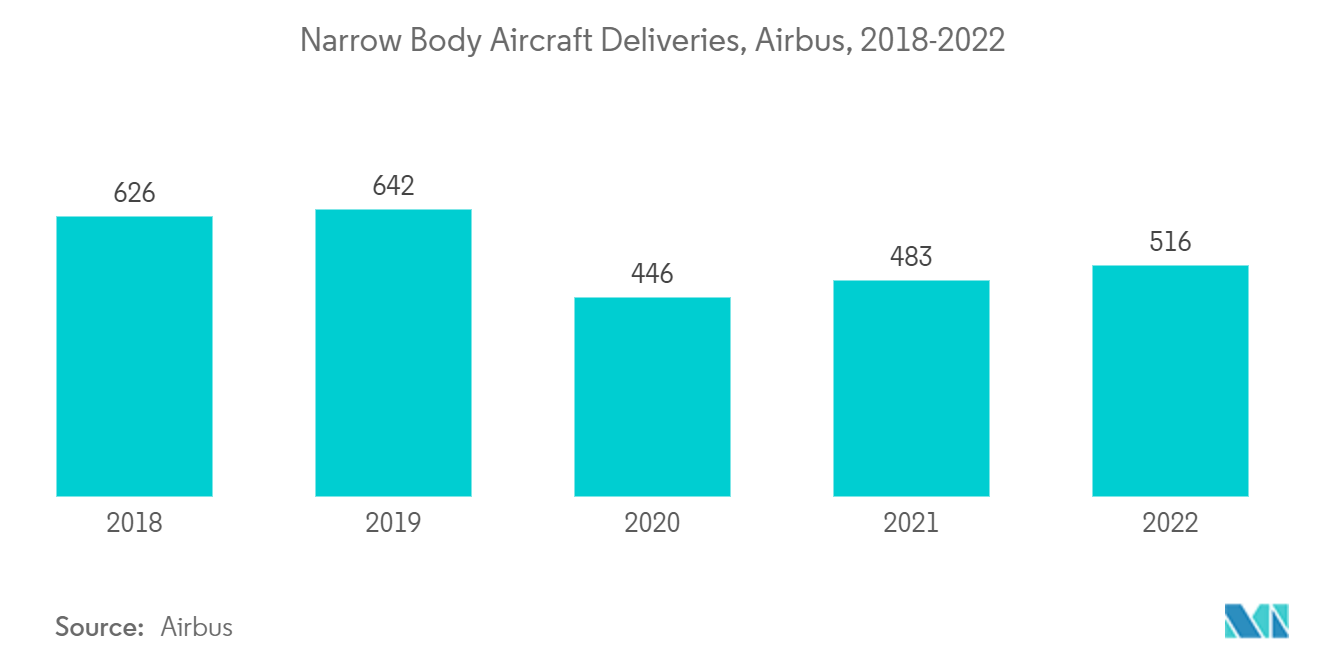Market Trends of Commercial Aircraft Carbon Brake Industry
The Narrow Body Aircraft Segment Is Expected To Witness Significant Growth During The Forecast Period
- By aircraft type, the narrow-body aircraft segment is expected to witness significant growth during the forecast period. There has been an increase in the number of narrow-body aircraft deliveries worldwide. The International Air transport Association (IATA) report projected that there will be 24,285 units of narrowbody aircraft in use globally by 2032.
- The growth of narrow-body aircraft worldwide can be attributed to the increasing demand for air travel, rising passenger traffic, and the growing need for fuel-efficient aircraft. According to the data released by the IATA, each new generation of aircraft is, on average 20% more fuel-efficient than the model it replaces. This has meant that narrowbody planes have become particularly viable for long-distance routes. As of the present scenario, the A321 neo-narrow-body aircraft has been the game changer aircraft since the A321 neo is the most efficient narrow-body aircraft and will continue to remain the same in the coming few years.
- Furthermore, additional benefits associated with narrow-body aircraft, such as ease of operations as well as flight connectivity to various airports, make the narrow-body a more profitable aircraft to be operated by various aircraft operators worldwide.
- On the other hand, the rising growth of narrowbody aircraft can be attributed to its extensive usage by Low-Cost Carriers of LCCs since the LCCs are more focused on cost reduction by minimizing crew and maintaining a high operational efficiency through technological advancements in aircraft maintenance and operations. This trend is expected to drive demand for narrow-body aircraft with self-support applications across various regions worldwide.
- The rapid growth in air transportation has challenged the industry to find new solutions to the ongoing challenge of meeting passenger demand while delivering increased efficiency in a hugely competitive marketplace. This has led to the development of aircraft such as the Airbus A321neoLR and the Boeing 737 MAX. These narrowbody aircraft offer increased range and efficiency, which makes it possible for them to compete in a market that had previously been dominated by widebody jetliners. For instance, the A321LR has a range of 7,400 kilometers, while the 737 MAX is also capable of reaching similar distances.
- Thus, an increase in the demand for new and efficient narrow-body aircraft to cater to the rising world air passenger traffic and with narrowbody aircraft being viable to fly long routes will propel the segment to growth during the forecast period.

Asia-Pacific Region is Expected to Witness Significant Growth During The Forecast Period
- By aircraft type, the narrowbody aircraft segment is expected to witness significant growth during the forecast period. There has been an increase in the number of narrowbody aircraft deliveries worldwide. The International Air Transport Association (IATA) report projected that there will be 24,285 units of narrowbody aircraft in use globally by 2032.
- The growth of narrowbody aircraft worldwide can be attributed to the increasing demand for air travel, rising passenger traffic, and the growing need for fuel-efficient aircraft. According to the data released by the IATA, each new generation of aircraft is, on average, 20% more fuel-efficient than the model it replaces, and this has meant that narrowbody planes have become particularly viable for long-distance routes. As of the present scenario, the A321 neo-narrow-body aircraft has been the game changer aircraft since the A321 neo is the most efficient narrowbody aircraft and will continue to remain the same in the coming few years.
- Furthermore, additional benefits associated with narrowbody aircraft, such as ease of operations as well as flight connectivity to various airports, make the narrow body a more profitable aircraft to be operated by various aircraft operators worldwide. On the other hand, the rising growth of narrowbody aircraft can be attributed to its extensive usage by Low-Cost Carriers of LCCs since the LCCs are more focused on cost reduction by minimizing crew and maintaining a high operational efficiency through technological advancements in aircraft maintenance and operations. This trend is expected to drive demand for narrowbody aircraft with self-support applications across various regions worldwide.
- The rapid growth in air transportation has challenged the industry to find new solutions to the ongoing challenge of meeting passenger demand while delivering increased efficiency in a hugely competitive marketplace. This has led to the development of aircraft such as the Airbus A321neoLR and the Boeing 737 MAX. These narrowbody aircraft offer increased range and efficiency, which makes it possible for them to compete in a market that had previously been dominated by widebody jetliners. For instance, the A321LR has a range of 7,400 kilometers, while the 737 MAX is also capable of reaching similar distances.
- Thus, an increase in the demand for new and efficient narrowbody aircraft to cater to the rising world air passenger traffic and with narrowbody aircraft being viable to fly long routes will propel the segment to growth during the forecast period.


